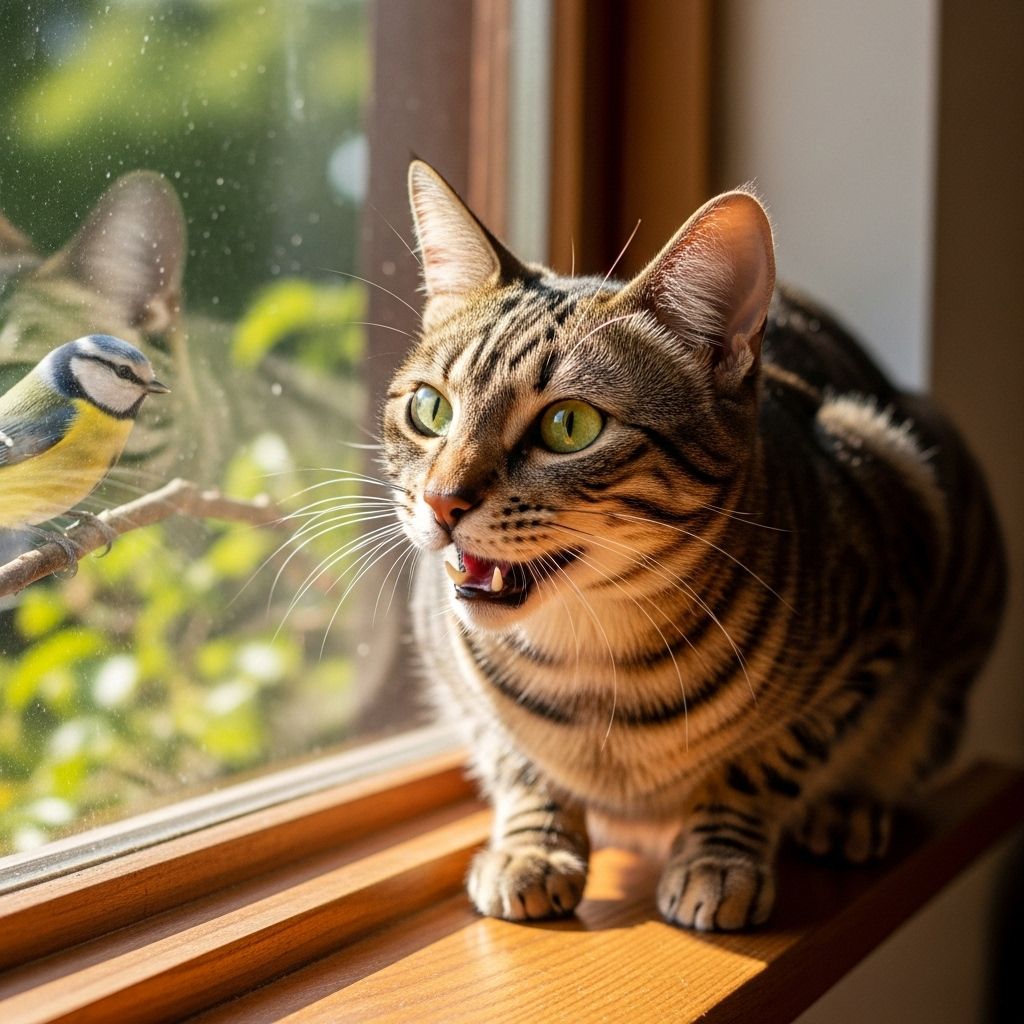Why Do Cats Chatter At Birds: Expert Insights And Instincts
Those quick jaw clicks reveal a primal drive and enhance their mental well-being.

Why Do Cats Chatter at Birds?
Anyone who has shared a home with a cat has likely witnessed the odd, rapid-fire chattering or chirping noises their feline makes when watching birds through the window. This behavior is accompanied by a laser-focused stare, a tense posture, and an unmistakable twitching jaw. What drives cats to produce these unusual sounds when observing birds and other wildlife? While definitive answers are elusive, researchers, behaviorists, and cat guardians have put forward several compelling hypotheses.
Understanding Cat Chattering: An Instinctual Feast
At its core, cat chattering is widely believed to be rooted in natural hunting instincts. Domestic cats retain many behaviors from their wild ancestors. When a cat spots a bird or a squirrel beyond reach—such as outside the window—its predatory drive kicks in. Unable to stalk or pounce, the cat venting that excitement or frustration may begin chattering. This occurs in a variety of contexts, but most often during the classic scene of a cat perched on a windowsill, tail flicking, jaw audibly clacking, and eyes locked onto flitting birds.
- Excitement and Frustration: Cats feel a surge of adrenaline when prey is visible but unreachable, such as birds on the other side of glass.
- Predatory Practice: Some theorists posit cats may be practicing hunting skills, including the mechanics of the death bite.
- Pent-up Energy Release: Chattering may be an outlet for the energy that builds during intense prey observation.
- Mimicry and Communication: Another theory suggests cats attempt to mimic the vocalizations of their prey, potentially as a strategy for attracting or deceiving them.
The Science and Theories Behind Chattering
Despite being a widely shared phenomenon, the precise cause of chattering remains unconfirmed by science. Leading animal behaviorists have put forth several key hypotheses:
- Adrenaline Rush: Sightings of prey trigger a flood of excitement-related hormones, manifesting as a rapid jaw movement and sound.
- Frustration Response: The inability to pursue visible prey creates frustration, which the cat expresses physically through chattering and tail swishing.
- Vacuum Activity: Anthopologist Desmond Morris described chattering as a ‘vacuum activity’—a behavior performed when the genuine activity (hunting) is blocked.
- Death Bite Simulation: Some experts observe that a cat’s chattering jaw mimics the muscle movements of delivering a killing bite to prey.
- Mimicry: While controversial, there are rare observed instances in nature (such as wildcats mimicking monkey calls) that suggest potential vocal mimicry.
The Role of Evolutionary Instinct
Even today’s highly domesticated companion cats are descendants of solitary hunters, optimized for stealth, patience, and lightning-fast attacks. Chattering frequently occurs when prey is close yet inaccessible, such as when your cat watches fluttering birds through a pane of glass. Experts believe this pent-up energy and frustration reflect an evolutionary adaptation: if a cat is prevented from acting on its instinct, it may channel those impulses into vocalization and repetitive movement.
Physical Manifestations and What Owners Observe
The most common settings for cat chattering include:
- Windowsills—cat stares out the window at birds, squirrels, or other wildlife.
- Watching videos—Some cats exhibit the same behavior when watching prey videos.
- Staring at toys—High-value toys shaped like birds or rodents may trigger chattering.
Owners most frequently report these accompanying physical signals:
- Alert, forward-facing ears
- Tense body posture
- Rapid tail flicking or lashing
- Wide, focused eyes
- Quivering jaw and distinctive chattering or chirping noises
Is Cat Chattering Normal?
For concerned cat owners curious about the loud burst of chattering, experts offer reassurance: this behavior is both normal and healthy. It is a vivid demonstration of your cat’s instincts and mental engagement. In fact, many behaviorists encourage enrichment opportunities that allow cats to safely watch and ‘hunt’ wildlife from indoors. The act of chattering can even help reduce boredom or provide needed mental stimulation, especially for indoor-only cats.
Can Chattering Mean Something Else?
While chattering at wildlife is almost always harmless, it’s important to note:
- If chattering is paired with signs of distress, anxiety, or compulsive behavior, consult a veterinarian. Extreme or frequent chattering unrelated to prey can be a sign of neurological or dental issues, but this is rare.
- Chattering at people, other cats, or in random contexts may suggest a different underlying cause, such as social signaling or attention-seeking.
Comparing Cat Chattering to Other Feline Sounds
| Sound | Typical Context | Likely Meaning |
|---|---|---|
| Chattering | Watching birds or prey | Pent-up hunting excitement or frustration |
| Meowing | Seeking attention, communicating | Varied; hunger, requests, greeting |
| Chirping | Watching prey, greeting humans | Excitement, mimicry, friendly intent |
| Growling | Defensive, threatened | Warning, discomfort |
| Purring | Relaxed, content | Affection, comfort |
Do All Cats Chatter?
Most, but not all, cats will chatter at visible prey from a safe distance. Factors that affect whether—and how often—a cat chatters include:
- Individual personality
- Early socialization and hunting experience
- Environmental factors (such as habitat, outdoor access, and available windows)
- Breed differences—no breeds are particularly prone, but high-energy breeds may chatter more frequently
Can You Encourage Healthy Chattering?
For indoor-only cats, providing environmental enrichment is crucial to mental well-being. Chattering is a healthy byproduct of stimulation, so cat owners can foster opportunities for this behavior:
- Window perches—Placing perches near windows allows cats to observe wildlife safely.
- Bird feeders—Place feeders outside windows (away from possible hazards for the birds), offering your cat plenty to watch.
- Interactive prey toys—Feather wands, laser pointers, and toy mice can induce hunting excitement and sometimes chattering.
- Video entertainment—Bird and squirrel videos designed for cats are widely available.
Debunking Common Myths
Just as cats are mysterious creatures, chattering is surrounded by myths and misconceptions. Let’s address some:
- Myth: Chattering means a cat is angry.
Fact: Most chattering is due to excitement or frustration, not aggression. - Myth: Cats are trying to “talk” to birds.
Fact: While mimicry is possible, cats cannot accurately reproduce birdcalls; most experts attribute the behavior to instinct, not communication. - Myth: Chattering is abnormal.
Fact: Chattering is typical and seen across the feline world.
Frequently Asked Questions (FAQs)
Q: Why does my cat only chatter at birds, not at other animals?
A: Cats’ vision and instincts are especially attuned to movement like that of birds and squirrels. Prey that exhibits rapid, unpredictable motion is more likely to trigger chattering; stationary targets, including some rodents or large mammals, generally do not provoke the same response.
Q: Is cat chattering ever a cause for health concern?
A: Chattering in the context of prey observation is normal and healthy. Abrupt changes in vocalization or chattering unrelated to prey should be discussed with a vet, especially if accompanied by other signs of illness or anxiety.
Q: Can kittens chatter too?
A: Yes, kittens may begin to chatter as soon as their hunting instincts develop. The behavior is most common as they age and begin actively watching birds or practicing play-hunting.
Q: Do outdoor cats chatter at birds?
A: Outdoor cats are more likely to engage in silent stalking, as noise could alert prey and spoil a hunt. Chattering appears most in situations where the prey is unreachable (e.g., behind glass).
Q: How can I provide safe entertainment for my chatter-happy indoor cat?
A: Window perches, bird feeders beyond predator access, and wildlife videos are safe, enriching options. Always ensure bird safety outdoors. Supervised play indoors is ideal.
Expert Insights and Research
Despite hundreds of years of observation, chattering remains only partially understood. Leading researchers suggest the following:
- Dr. Marci Koski, certified feline behaviorist, notes that chattering is an expression of unique excitement and should be encouraged as an enriching, mentally stimulating activity.
- Wildlife researchers in South America have observed wildcats mimicking prey sounds—though such mimicry is rare, it suggests a possible evolutionary function behind odd feline vocalizations.
- Contemporary behaviorists emphasize the importance of providing indoor cats with access to sights, sounds, and safe observing opportunities.
Ultimately, chattering is a window into the hunter’s heart—a blend of ancient instinct, modern frustration, and feline intelligence. It is one more reason to delight in your cat’s mysterious and multifaceted personality.
References
- https://www.cats.org.uk/cats-blog/why-do-cats-chatter-and-chirp-at-birds
- https://catinaflat.com/blog/why-do-cats-chatter-at-birds
- https://www.meowingtons.com/blogs/lolcats/this-is-why-cats-chatter-at-birds-according-to-science
- https://www.thecatbehaviorclinic.com/why-do-cats-chatter/
- https://www.chewy.com/education/cat/training-and-behavior/why-do-cats-chirp-at-birds
Read full bio of Srija Burman












